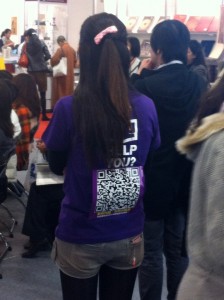I am currently attending the TIBE Exposition in Taipei, Taiwan, a massive spectacle of all things books. It is basically the Frankfurt Book Fair Asian edition. In a nifty nod to mobile as information disseminator, many of the staff are wearing QR codes underneath “May We Help You?”. So essentially you have the choice of interacting with staff verbally or electronically. I think it is more fun than useful, which perhaps is the whole point. Playful appropriation of technology for creative effect.
I do wonder how much of this QR code is designed to avoid language difficulties (English, Cantonese, Mandarin, Thai, Japanese, Korean all heard so far) and facilitate a comfortable interaction. Perhaps a softer, more efficient, less confusing Help dissemination tool. Yet I whimsically (and perhaps illogically) lament the softening of culture shock, those raw encounters of limited vocabulary (if any), hand gestures, smiles, and a mutally negotiated understanding. Fraught with potential pitfalls, for sure, but quite a bonding experience.
Does this QR code signal the passing of those encounters? Not really, no. Perhaps just a lessening. But it does indicate a slow progress towards presenting individuals with the conscious decision of whether or not to interact with other people verbally in physical space. For people like me, despite working professionally in a public sphere (and with little to no stage fright), socialization on the smaller scale is something that I need to engineer into my reality, to almost force myself to do. I greatly benefit from the encounter, but I need a prod to get there. For me and others like me, this gives me an option of not having to interact at all.
On a side note, perhaps this is the future of docent guides? Not necessarily a QR code (as they are limited and fading), but embedded technology to tailor guides to personal interests of the patrons? All found on the body of the docent. As a kid, I always wondered if it were possible for humans to be telepathic, to speak only with their minds. I always imagined this occurring as a result of extraordinary intellect or unlocking some deep recess of the human brain, but it won’t be like that. It will be like this QR code scenario, a telepathy fostered through technology, an augmentation of personal interaction. To speak with another through technology without an audible voice (or even in parallel to an audible voice). Or, perhaps more likely, a person talking to another person about something while our technology talks about us. Not an unlikely scenario simply because there is a competitive social advantage to doing so. That is generally enough to trigger adoption.
Perhaps I just miss my wife.

